A Taste of Food and Cooking Manga
Exploring the Origins of Cooking Manga Plus 10 Tasty Titles to Try
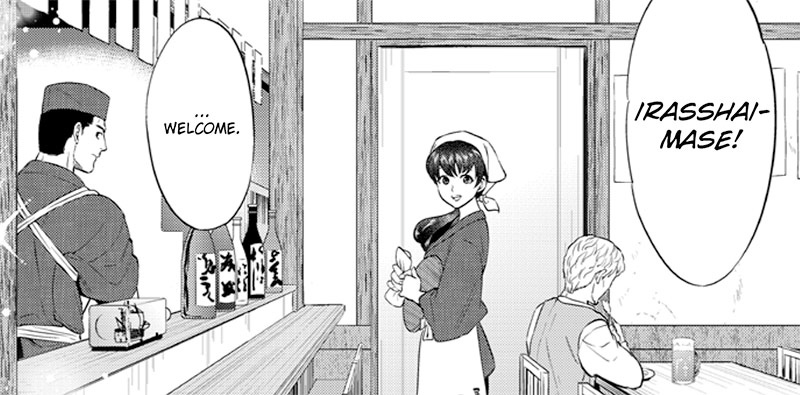
A Taste of Food and Cooking Manga
By Deb Aoki
On the March 25, 2002 episode of Christopher Kimball’s Milk Street Radio podcast, I was invited to chat a bit about food and cooking manga! You can listen to the episode here:
As part of this chat, I pulled together a list of some of my favorite food and cooking manga, and gathered some background info about some of the early examples of this delicious manga genre that I thought would be fun to share with Mangasplaining Extra readers!
One of the things I love most about manga is that it can be about almost anything: sports, science fiction, romance, history, families, animals, fantasy, office life and almost every combination of those things and more. One of the most interesting genres of manga focuses on something that Japanese people… well, okay, something that almost everyone loves: food!
Cooking and food manga tell a story while incorporating information about food, drinks, ingredients and how to cook and serve tasty meals into the plot. The best food and cooking manga can teach you something new, like a recipe or a cooking technique, or how wine and sake is made, introduce you to a new restaurant, or it can simply teach you ways to appreciate the ingredients that go into the food you eat. There’s a lot of food and cooking manga out there, and we’ve really only gotten a handful of them translated and published in English.
Whether you’re new to cooking or you’re a hardcore “foodie,” there’s a food manga for you to try.
Four types of cooking/food manga
There’s all kinds of manga about food and cooking – but most can be classified as one or a combination of these four basic genres:
Ryouri Manga - Cooking manga
Often includes recipes and step-by-step cooking instructions. Examples: What Did You Eat Yesterday? Today’s Menu for the Emiya Family, Food Wars
Tabe Manga - Manga about eating or ingredients
“Tabe” comes from the Japanese words tabemono (food) and tabemasu (eating). Examples: Oishinbo, Silver Spoon, Delicious in Dungeon
Gurume Manga - “Gourmet” manga
Manga about dining out. Many gurume manga feature real restaurants found in Japan and abroad. Examples: The Solitary Gourmet, Oishinbo, Not Love But Delicious Food Makes Me So Happy
Nomi Manga - Drinking manga
Usually refers to manga about enjoying wine, sake, whiskey and cocktails or going to bars “Nomi” comes from the Japanese words “nomimono” (beverages) and “nomimasu” (drinking). Examples: The Drops of God, Wakakozake
Think of it as similar to how there are different types of books about food — cookbooks, books about food/ingredients, restaurant guides/reviews or dining experiences and food journalism, and books about wine tasting or whiskey or sake. A little something for every kind of food-lover!
Early Food Manga
So how did food manga emerge on the scene in Japan? The beginnings of food manga in the early 1970s coincide with the growing middle-class affluence of everyday Japanese people. WWII and the years after left many Japanese people with memories of poverty, hardships and food shortages. As Japan grew into an industrialized and prosperous nation, dining out and savoring good food and drinks became something that was more within the reach of the average Japanese person.
Around the same time, manga’s influence as pop culture entertainment in Japan was growing. People of all ages, boys and girls, men and women read manga for fun. Vast arrays of manga and manga magazines can be found in most bookstores, convenience stores and train stations. Before mobile phones, it was common to see people reading manga while commuting on trains. Manga was (and is) a cheap, fun, portable and enjoyable form of entertainment.
Compared to North American comics, there’s just so much more manga produced, sold and read in Japan on an everyday basis. Some popular manga magazines typically sell over a million copies weekly or monthly. At its peak, from the mid-1980s to 1990s, Weekly Shonen Jump sold about 6 million copies a week, with a readership of over 18 million people. (Today, the weekly print edition sells closer to 1.9 million copies/week but has many more readers reading the digital edition of this magazine online, both in Japan and worldwide).
By comparison, the typical issue of Spider-man or Batman maybe sells 129,000 copies. Check ComicChron for their lists of the best selling comics in N. American comic shops for 2021 for more on this: https://www.comichron.com/monthlycomicssales/2021.html
While there are lots of food and cooking manga published now, three series that emerged in the early 1970s are frequently mentioned as the foundation for the popularity of the genre today.
Totsugeki Ramen (突撃ラーメン) by Michiya Mochizuki. Serialized in Weekly Shonen Jump (Shueisha) 1970-1971
Totsugeki Ramen debuted in Weekly Shonen Jump issue 9 in 1970, a few years after this shonen manga magazine’s launch. According to Mochizuki, this series was considered experimental at the time, since no one had really tackled food and fighting together as the premise for a manga series (Like Mangasplaining fave Golden Kamuy, Totsugeki Ramen also includes scenes from the Russo-Japanese war!) It’s a comic that used food as a way to express fighting spirit and competitiveness.
“Totsugeki” means “charge,” and in the excerpt above, you can see the main character on horseback on the battlefield. The story focuses on a young man who inherits a ramen shop from his father. He then has to fight against a Chinese chef who drove his father to suicide, and along the way, embarks on a journey to learn how to make great ramen.
Houchouinin Ajihei (Ajihei the Cook) (包丁人味平) by Jiro Gyuu, Jou Biggu, serialized in Weekly Shonen Jump (Shueisha) 1973-1979
After Totsugeki Ramen, another food-centric series joined the lineup in Shonen Jump in 1973 : Hochounin Ajihei or Ajihei the Cook.
This time, the story captures a young boy’s efforts to become a successful professional chef. "Houchou" literally means "kitchen knife,” and Houchouinin Ajihei is considered to be one of the best known examples of “work manga,” or manga about a profession. The series ran for 23 volumes, and ended in 1979.
The main character, Ajihei grew up looking up to his father, a chef who specializes in traditional Japanese cuisine. But to his father’s dismay, once Ajihei is old enough to strike out on his own, the idealistic young man takes a job in a fast food restaurant. Why does Ajihei do this? Because he wants to create and serve inexpensive, tasty food for everyone.
The writer of the series, Jiro Gyuu, had experience with working in a restaurant, so he adds a lot of real-life detail about what it takes to work in the food and hospitality business to this manga. The manga inspired more than a few young readers to take up cooking as a career, so ramen shops called “Ajihei” popped up in Tokyo as a result of this manga’s popularity.
While it’s not currently available in English, you can read a sample chapter of Houchounin Ajihei in Japanese here: https://mavo.takekuma.jp/viewer.php?id=569
Cake Cake Cake by Moto Hagio and Aya Ichinoki, serialized in shojo manga magazine Nakayoshi (Kodansha), 1970
One of the earliest examples of food-centric shojo manga is Hagio Moto’s Cake Cake Cake. Originally serialized in Nakayoshi, a manga magazine aimed at young girls, Cake Cake Cake introduced readers to story conventions that are now staples in food and cooking manga.
Cake Cake Cake is centered around a young Japanese girl who falls in love with French pastries and desserts. She loves eating these sweet treats so much, she starts singing when she gets to try a particularly yummy treat. Eventually, this love of French-style desserts takes her to France, where she starts honing her skills as a pâtissière.
Cake Cake Cake is one of the earliest examples of including the “reaction shot” – that moment when the characters express a moment of delight, as they savor the flavors of what they’re eating. This is a key part of food and cooking manga since most manga is drawn in black and white, so trying to convey how delicious something is can be challenging without full-color illustrations.
While this story isn’t available as an official English release, you can see more about Cake Cake Cake here: https://www.hagiomoto.net/works/006.html and here: http://leodraco.blog120.fc2.com/blog-category-31.html
Thanks to Khursten Santos for her article about Food Manga for turning me on to some of these early food manga.
10 Tasty Food and Cooking Manga to Try
So, have we convinced you to give food manga a try? Here’s ten tasty titles that will get your mouth watering.
1. Oishinbo by Tetsu Kariya and Akira Hanasaki (VIZ Media / Shogakukan)
Gurume Manga / Tabe Manga / Nomi Manga sometimes Ryori Manga
Published in English by VIZ Media. 7 Volumes available now.
At 111 consecutive manga volumes, Oishinbo is the 12th best-selling manga of all time. It ran in Shogakukan’s Big Comic Spirits magazine from 1983 to 2014. The “hero” of Oishinbo is Shiro, a seemingly lackadaisical reporter at a newspaper. But Shiro’s laidback style hides a secret: he’s actually an accomplished chef and gourmand. Why? It’s partly because his estranged father is a famous artist/world-class gourmet / food snob, and while they hate each other now, Shiro learned a lot about food thanks to his upbringing.
When the newspaper that Shiro works for decides to look for the “ultimate menu” as part of their upcoming anniversary, this quest for Japan’s finest dishes puts Shiro squarely at odds with his father, who has been assigned a similar quest.
The family drama simmering in the background is mostly an excuse for Shiro, his colleagues and rivals to take readers on a journey through Japanese and international cuisine, cooking and ingredients that will astonish even the most experienced foodie!
For North American readers, seven “a la carte” volumes are available in English, published by VIZ Media. Each volume is a thematic collection of stories on different aspects of food, including: Ramen & Gyoza, Sushi & Sashimi, Sake, Rice, Vegetables, Izakaya food, and a general primer on Japanese Cuisine.
There’s also an Oishinbo anime channel (Japanese with English subtitles!) on YouTube: https://www.youtube.com/channel/UCeyC9t-tByuko20fzMwXr4w
The crew has also discussed Oishinbo on the Mangasplaining Podcast! Go check out Mangasplaining episode 12 - https://www.mangasplaining.com/blog/ep-12-oishinbo/
Oishinbo also includes some recipes and techniques mentioned in the stories, so you can try some of the dishes described in this foodie comic for yourself!
2. What Did You Eat Yesterday? by Fumi Yoshinaga
Ryori Manga / sometimes Gurume Manga
Published in English by Kodansha. Vol 1-17 available now.
Shiro is a closeted gay lawyer who likes to cook. He lives with his boyfriend Kenji, who is an out hairdresser. This slice of life manga shows how both Shiro and Kenji cook simple, usually healthy, often inexpensive but tasty meals for each other, with an emphasis on menus that are easy/fast for busy working people in their 30’s-40s’ to make after a busy day.
Yoshinaga gets into how to use up leftovers in the fridge, how to plan menus that are the right mix of flavors and textures that don’t make you feel heavy after you finish eating. She mostly spotlights Japanese food, but there’s lots of other cuisine featured too, like Italian or Spanish dishes. She also sometimes spotlights real restaurants in Japan, like an eel restaurant where Shiro meets Kenji’s mother and sisters for the first time, that actually leads up to a conversation about how things will go if Kenji dies before Shiro, and how his mother wanted to know Shiro so he could be part of the family at the funeral, if/when that happens(!).
As the story progresses, you see the pair grow older. They deal with aging parents, neighbors, friends, co-workers and just everyday life as a long-term gay couple living in Tokyo, in a Japan that is slowly starting to accept gay people and gay/lesbian partnerships.
I’ve actually made some of the recipes featured in this manga – like this recipe for dry curry (read left-to-right):
Fans of live-action J-dramas take note! A live action television adaptation was created for What Did You Eat Yesterday, and it even got a big screen movie adaptation at the end of last year!
3. The Drops of God, By Tadashi Agi and Shu Okimoto
Nomi Manga / Tabe Manga
Published by Kodansha. 44 volumes digital, 5 print.
Named by Decanter Magazine as one of the most influential wine publications in the world, The Drops of God has been a driving force behind the increased interest in wine in Asia. Why? Mostly because The Drops of God features real wines that readers can find, buy, and taste, and introduces the finer points of wine appreciation in a way that's both accessible and entertaining, like comparing the impact of tasting a fine wine with the experience of hearing Bohemian Rhapsody by Queen for the first time, or the sensation of being in a field of flowers after sniffing the bouquet of a burgundy.
Many wines featured in the Drops of God go on to sell out or have their name brand value go up significantly in Asian markets. And while Drops of God doesn’t skimp on mentioning the heavy-weights / pricey wines like Chateau Mouton Rothschild and Screaming Eagle, it also spotlights wines that are more affordable too. It often cautions readers about the dangers of ordering wine just because it’s pricey, not serving it with respect, or serving wines that don’t pair well with the food being served.
The main character of Drops of God is Shizuku, the son of a famous wine critic who has turned his back on his father's world. But when his father dies and leaves a will that stipulates that his son must compete with an arrogant young wine critic to identify the wines his father describes in cryptic poem/riddles in order to inherit a multi-million dollar wine collection. Shizuku takes up the challenge and with some help from his friends (including a pretty sommelier-in-training) he embarks on a globe-trotting journey of exciting tastes, places, and experiences that takes him to famous wine regions in France, Italy, Napa Valley, Australia and beyond.
Fun fact: Creator ‘Tadashi Agi’ is a pen name, for brother/sister team Shin and Yuko Kibayashi
4. Food Wars! Shokugeki no Soma. By Yuto Tsukuda and Shun Saeki with Yuki Morisaki (food consultant)
Ryori Manga / Tabe Manga
Published by VIZ Media. Available in 36 volumes, print & digital
Anime on Netflix: https://www.netflix.com/title/80182054
Yukihiro Soma is a cocky teenager who loves to cook, and has been a working chef at his family’s diner for years – but one thing frustrates him intensely: the fact that he has yet to beat his father in their ongoing cooking competitions.
So when his father ships him off to an exclusive boarding school, it’s not just any private school – it’s the Totsuki Institute, an elite academy designed to pump out the best of the best chefs in the world. It’s here that he meets other kids his age who specialize in different aspects of food and cuisine, everything from meat, seafood, ramen, smoked foods and even molecular gastronomy.
It’s called “Food Wars” because there’s also a “competition” element here, as the students go heads up against each other and sometimes other world-class chefs in “Iron Chef” type cooking battles called “shokugeki”, complete with world-class/celebrity judges, where the stakes can go as high as the risk of being expelled from school. Students are also sent on challenging apprenticeships in real restaurants or hotels that give them a taste of the stress of cooking for guests in a professional kitchen.
But what makes Food Wars such a hoot is that when a character tastes something REALLY delicious, it’s expressed as a fit of ecstasy that makes their clothes explode off their bodies. And it’s not just the girl characters – male, female, young, old all are vulnerable to these increasingly absurd expressions of “OMG this is sooo good” naked joy.
While some dishes are out of this world, several chapters include simplified real-world worthy recipes that readers can try to replicate the flavors of Food Wars.
5. The Solitary Gourmet, by Jiro Taniguchi and Masayuki Kusumi
Gurume Manga
Published by Fanfare-Ponent Mon (coming Spring 2022)
From Fanfare Ponent Mon’s description of this much-anticipated food manga:
What do we learn about Mister Inogashira? He’s a sole, independent businessman who imports household and fashion goods from France. He is always busy but never rushed as he travels around Japan selling his wares. He’s also a private person who, whilst he enjoys the company of women, prefers to remain a bachelor. He smokes cigarettes but never touches alcohol. But above all, he enjoys his food! He is The Solitary Gourmet!
Written by Masayuki Kusumi, a real-life solitary gourmet (more on him here) and illustrated by Mangasplaining fave Jiro Taniguchi, The Solitary Gourmet features real restaurants that readers can visit and try for themselves. I’ve actually been to one of them, Kayashima in Kichijoji (a neighborhood in Tokyo), and it’s exactly as described in the manga.
The Solitary Gourmet was adapted into a popular live action TV series that (unfortunately) is not yet available on English language video streaming sites, but hopefully with the success of Midnight Diner on Netflix, that may change someday? I hope?
6. Emma Dreams of Stars, By Kan Takahama, with Emmanuelle Maisonneuve and Julia Pavlowitch
Gurume Manga
Published by Kodansha in 1 volume, print and digital.
Based on a real-life account of a young woman’s journey to become and succeed as a Michelin Guide inspector! This title is unique in that features a Japanese manga-ka creating this manga, but the title was originally created for the French comics market. Therefore we get a rare full-color food manga capturing the exquisite cuisine in all of its mouth-watering glory! Emma Dreams of Stars offers an inspiring story of a young woman striving in a field where most of her fellow inspectors (were, at the time) mostly older and mostly male.
7. Silver Spoon, by Hiromu Arakawa
Tabe Manga
Published by Yen Press. Available in 15 Volumes, print and digital.
Anime on Funimation
Burnt out from the pressures of trying to live up to his stern father’s demands, city boy Hachiken opts to go to a very different type of high school: Ooezo Agricultural High School in Hokkaido, the northern farmlands of Japan. While there, he learns the finer points of mucking out stables, raising pigs (and turning them into bacon), making cheese and building his own pizza oven. Along the way, he learns that his classmates’ lives as next generation farmers are actually a lot harder than it looks.
Hiromu Arakawa (creator of smash-hit action-adventure series Fullmetall Alchemist, also a Mangasplaining podcast pick) grew up in Hokkaido in a farming family, and this manga is full of thoughtful insights about the joys and challenges of running a family farm. It also offers a clear-eyed, compassionate view about family farms and industrial farming, and what it means to raise animals and eat them.
8. Delicious in Dungeon, by Ryoko Kui
Ryori Manga, Tabe Manga
Published by Yen Press. Available in print and digital.
Remember when we covered this manga on the Mangasplaining Podcast? It was allll the way back in episode 2!
When young adventurer Laios and his company are attacked and soundly thrashed by a dragon deep in a dungeon, the party loses all its money and provisions...and a member – his sister!! They're eager to go back and save her, but there is just one problem: If they set out with no food or money to speak of, they're sure to starve on the way! But Laios comes up with a brilliant idea: "Let's eat the monsters!" A unique, often funny twist on a Dungeons and Dragons-type story crossed with campfire cooking techniques.
Delicious in Dungeon starts off with a “let’s find weird stuff and cook it” theme, but as the story progresses, more characters and their backstories are introduced. The plot thread about finding the lost member of their adventuring party intensifies and kicks the dramatic stakes up several notches, making this series worthy of its 10+ volumes of story.
9. Otherwordly Izakaya Nobu, by Natsuya Semikawa and Virginia Nitouhei
Tabe Manga
Published by UDON Entertainment. Available in Print & Digital.
Anime on Crunchyroll
In a world of knights, mages and adventurers, dungeons and dragons – there’s a place where the denizens of this fantasy world go to kick back and enjoy some magically delicious pub eats (and drinks): Izakaya Nobu. It’s an otherwise everyday Japanese Izakaya (think: gastropub), except that it’s located in a magical Medieval European city where the diners who visit it have never experienced the joys of Japanese food!
Seeing these quasi-European characters react in amazement and ecstasy when they taste otherwise everyday Japanese dishes is fun to see. It’s a fun and mouth-watering slice-of-life story that mixes fantasy fun with foodie tidbits. In later volumes, the locals share their German- and French-inspired dishes with the Japanese pub owners too, making for a great cultural collaboration!
10. Something’s Wrong With Us, By Natsumi Ando
Tabe Manga
Published by Kodansha. Available in 7 volumes, print & digital.
From the creator of Kitchen Princess, a “spine-chilling and steamy romance” between a young woman and the man who framed her mother for murder! Something’s Wrong With Us is centered around the world of wagashi - traditional Japanese sweets, like mochi, manju, monaka, yokan and more. Ando offers some fascinating details about the ingredients, techniques and traditions of wagashi, along with the romance and dramatic plot twists of this story.
From the publisher:
Following in her mother’s footsteps, Nao became a traditional Japanese sweets maker, and at 21, she’s about to take the industry by storm. With unparalleled artistry and a bright attitude, she gets an offer to work at a world-class confectionary company. But when she meets the young, handsome owner, she recognizes his cold stare … It’s none other than Tsubaki, her childhood friend and first crush – the same boy who stood over his father’s bloodied body 15 years ago, and framed Nao’s mother for the murder.
As the only witness of that fateful night, Nao is eager to chase down the truth and confirm her suspicions. Since Tsubaki has no clue who she is, she seizes her chance to get close to him, but instead of finding any answers, she begins falling for him, and soon enough, marries him. But now that she’s closer than ever to finding the answers to the questions that have tormented her about her mother’s fate, Nao find herself getting tangled in a web of secrets and long-held grudges that might get her killed.
But wait, there’s more…!
That’s a LOT of writing about food manga! In addition to the history and origins of food manga, as well as Deb’s top-ten picks for new readers, she also tracked down another huge batch of food manga for fans to enjoy, including more shonen battle food manga like Food Wars, more ‘otherworldly’ cuisine like Delicious In Dungeon, some VERY deep-dives into food culture that give Oishinbo a run for its money, and even a wide variety of full-on food manga cookbooks!
We’ll be back in two weeks with part two of this food manga odyssey here on Mangasplaining Extra, which should give you just enough time to check out the ten+ titles listed above! Look for them at the listed links, check out your local comic and manga specialty shop (find one near you at Comicshoplocator.com), and don’t forget that many public libraries offer print and digital lending options for manga!
On next week’s bonus article: A very rare interview between three manga masters!
Thanks for reading!






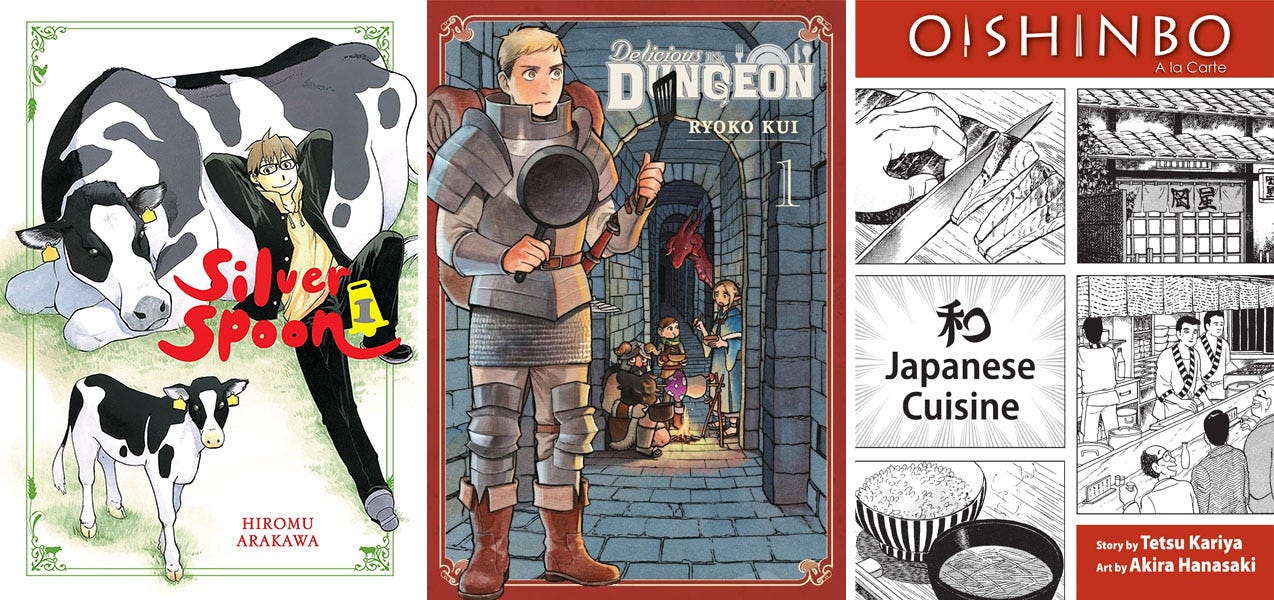
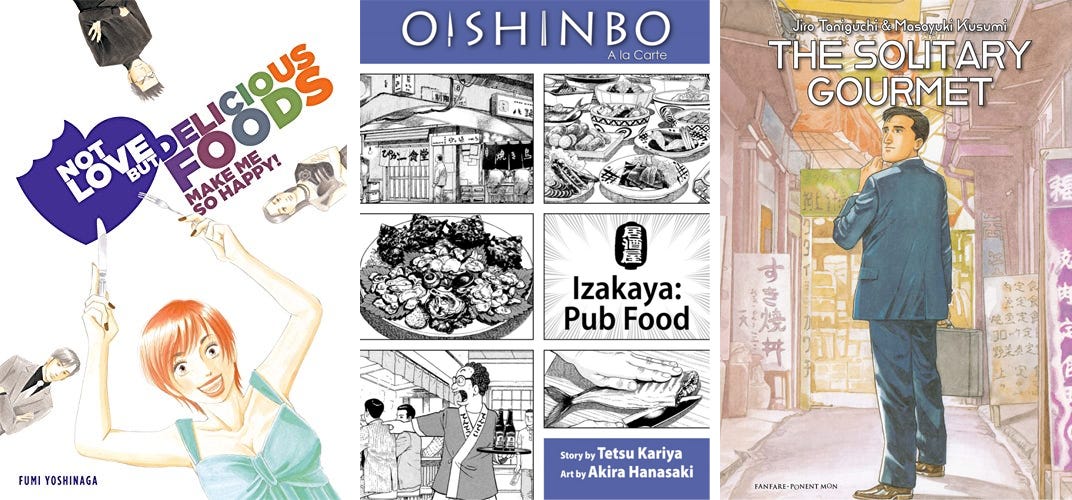

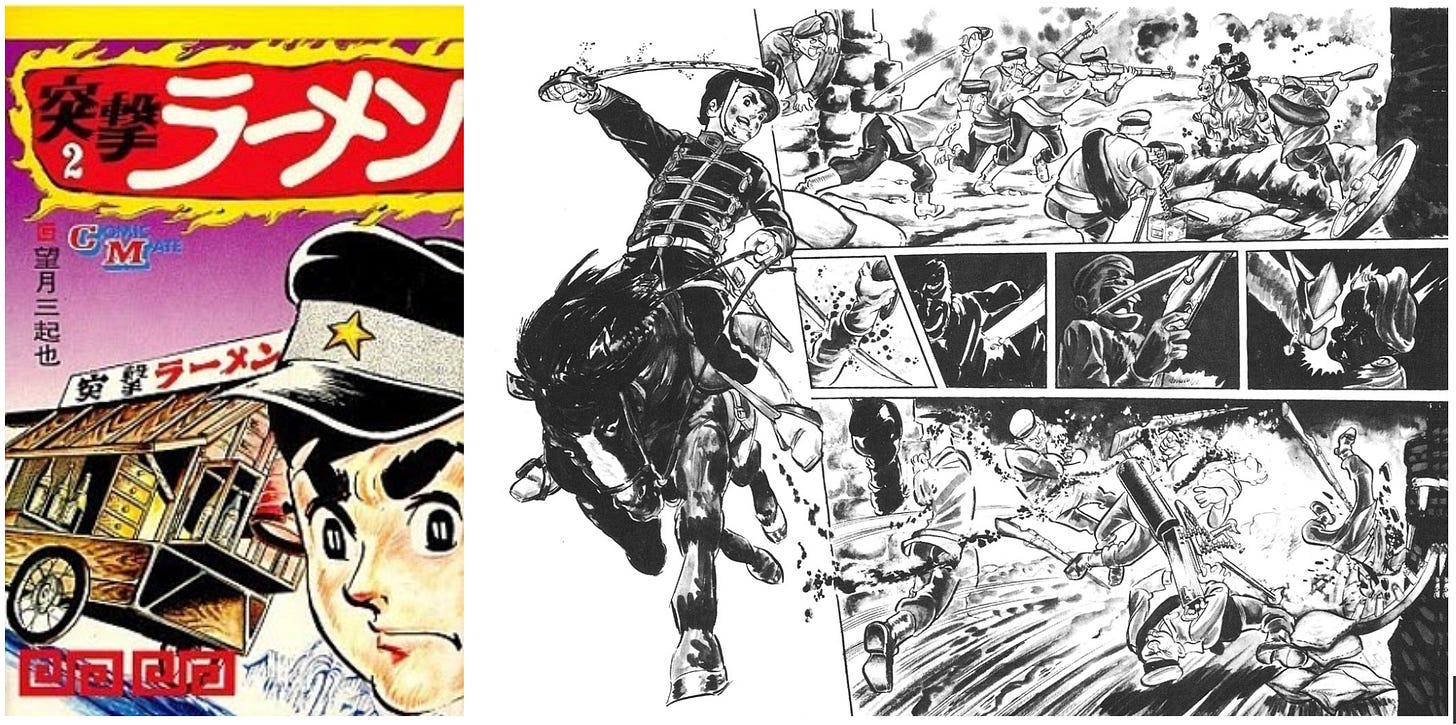












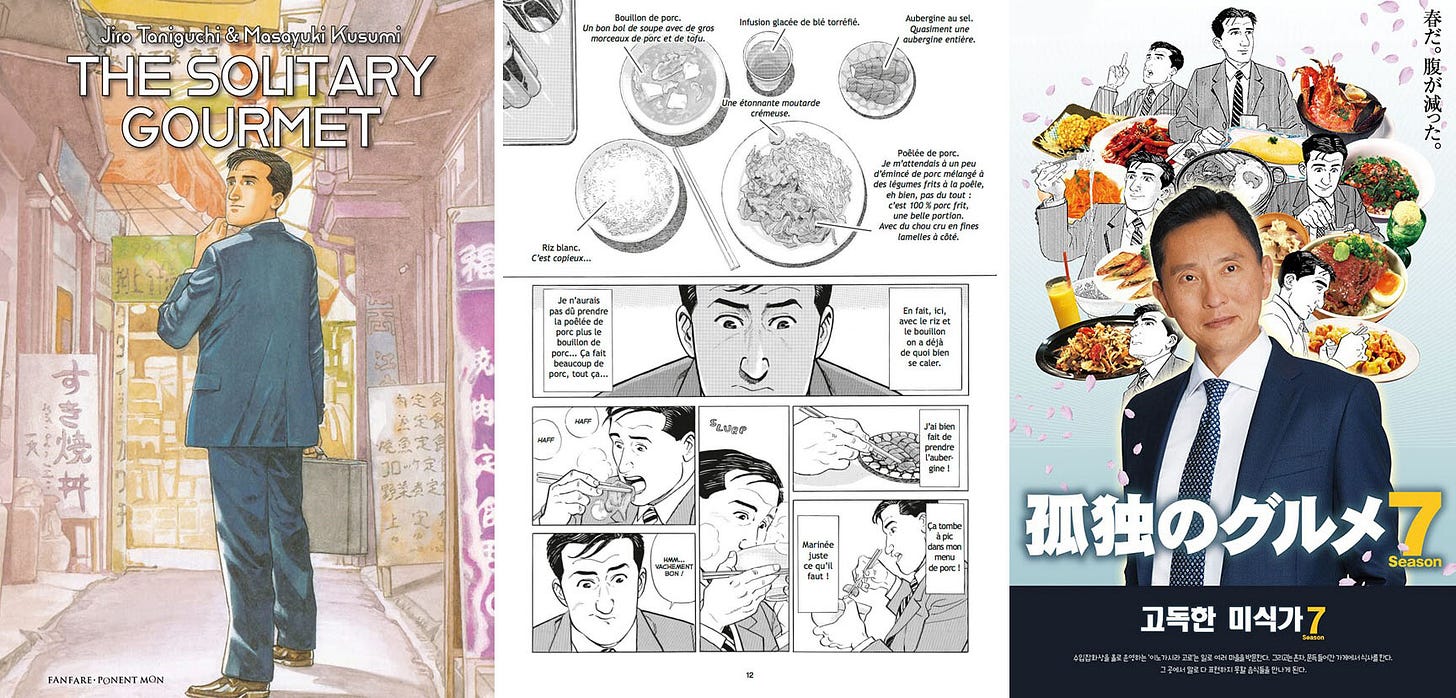
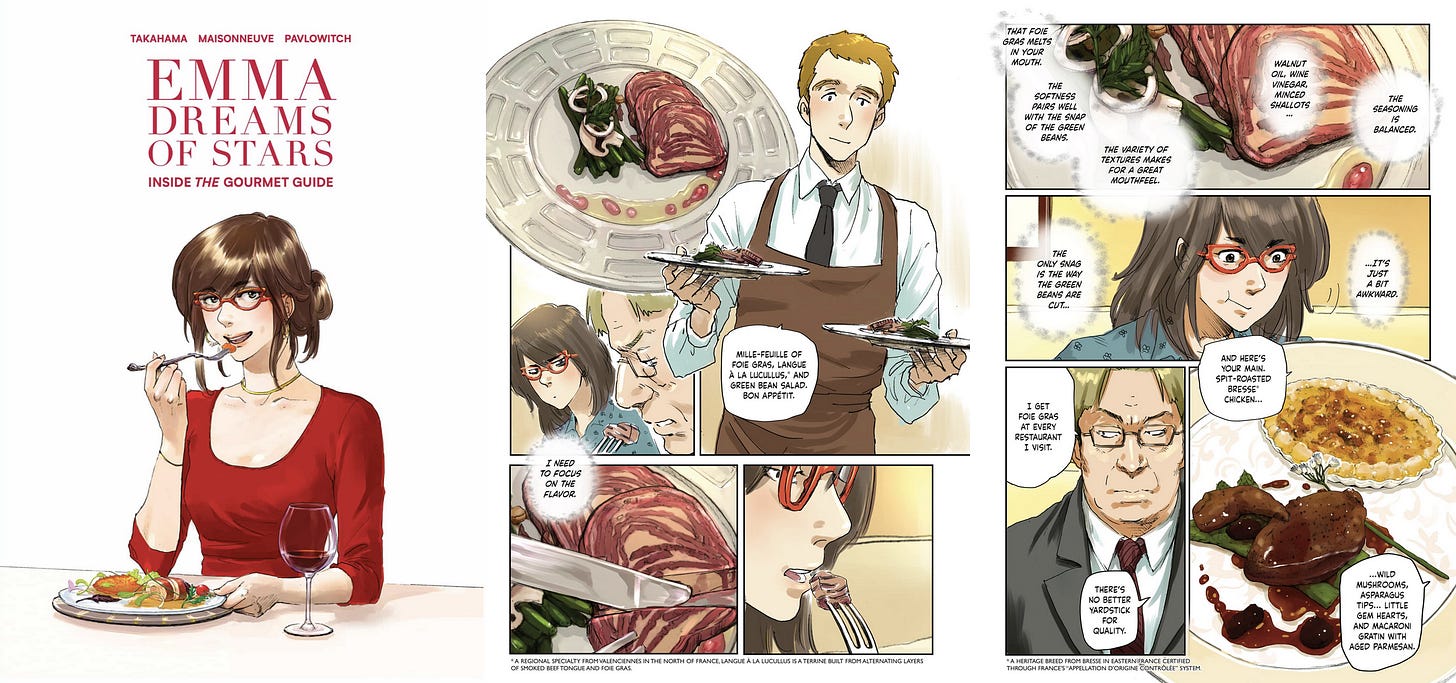

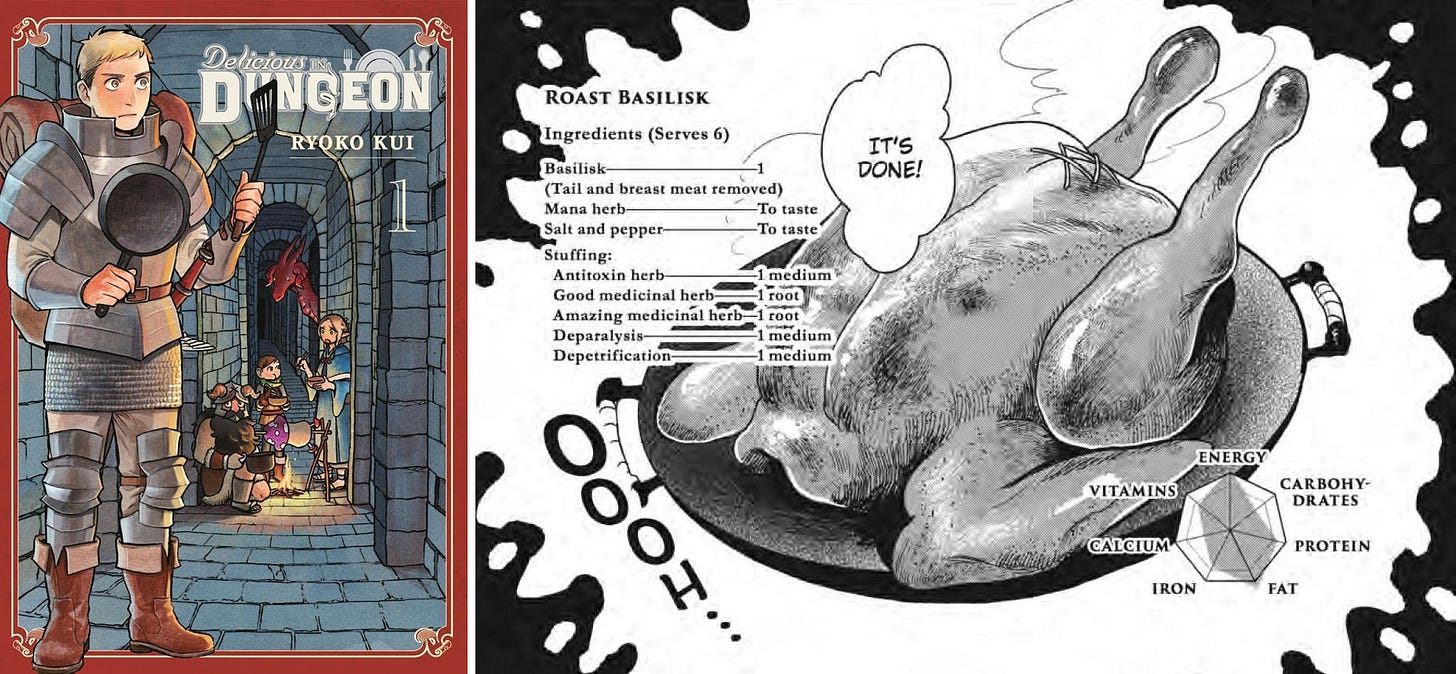
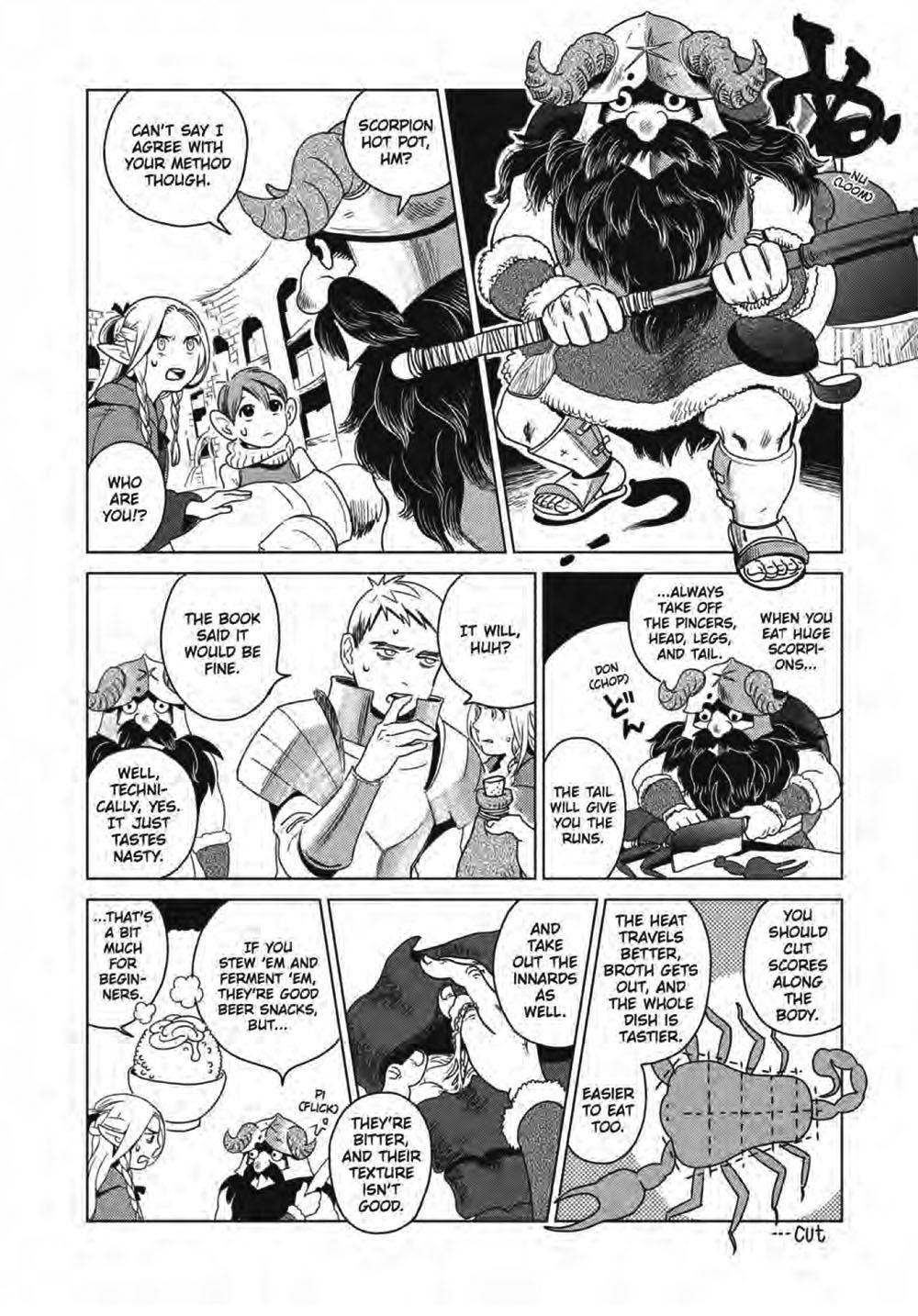

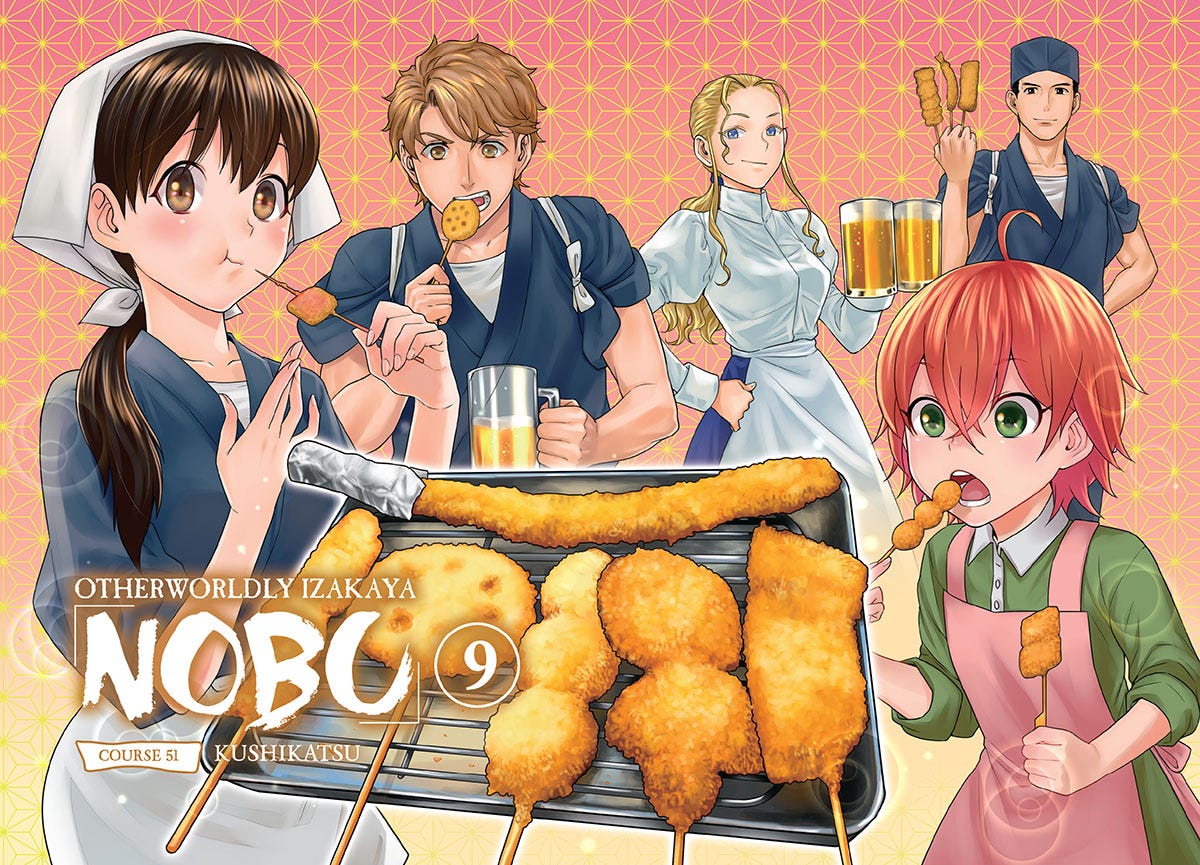
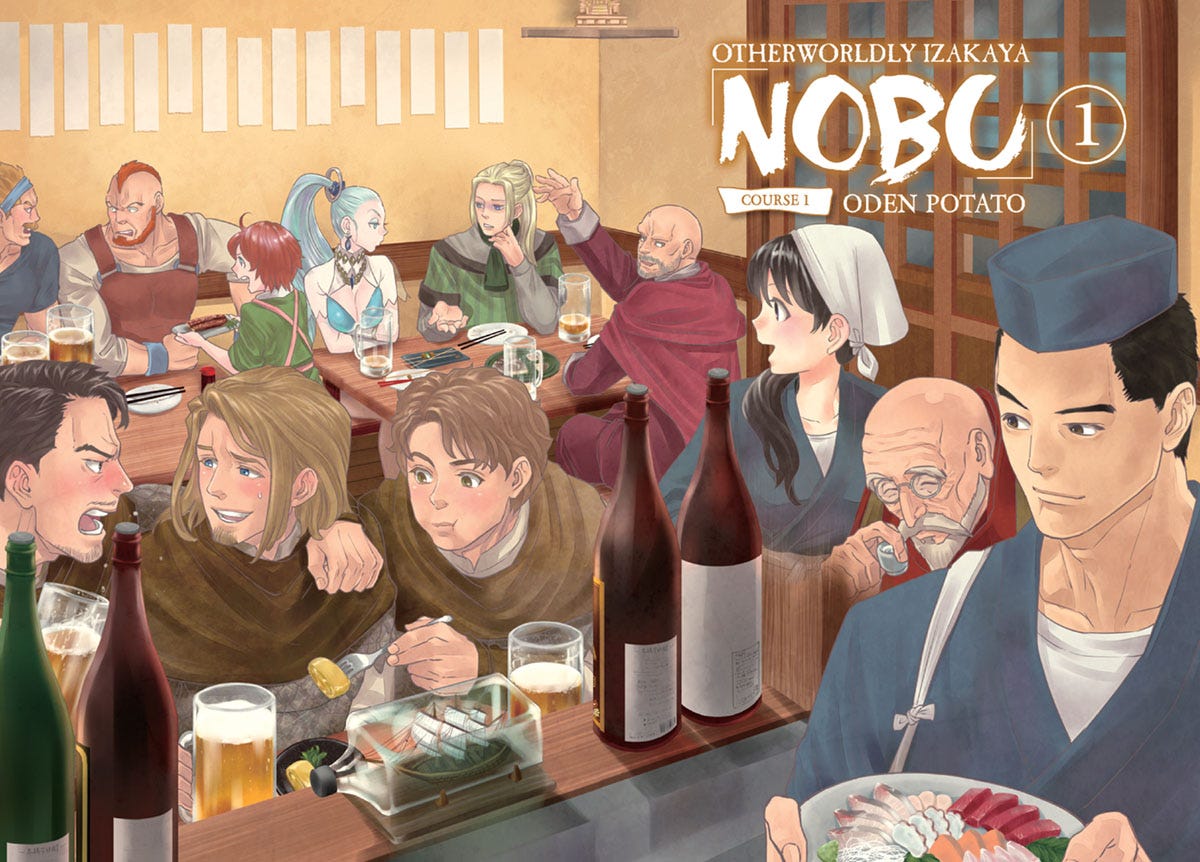

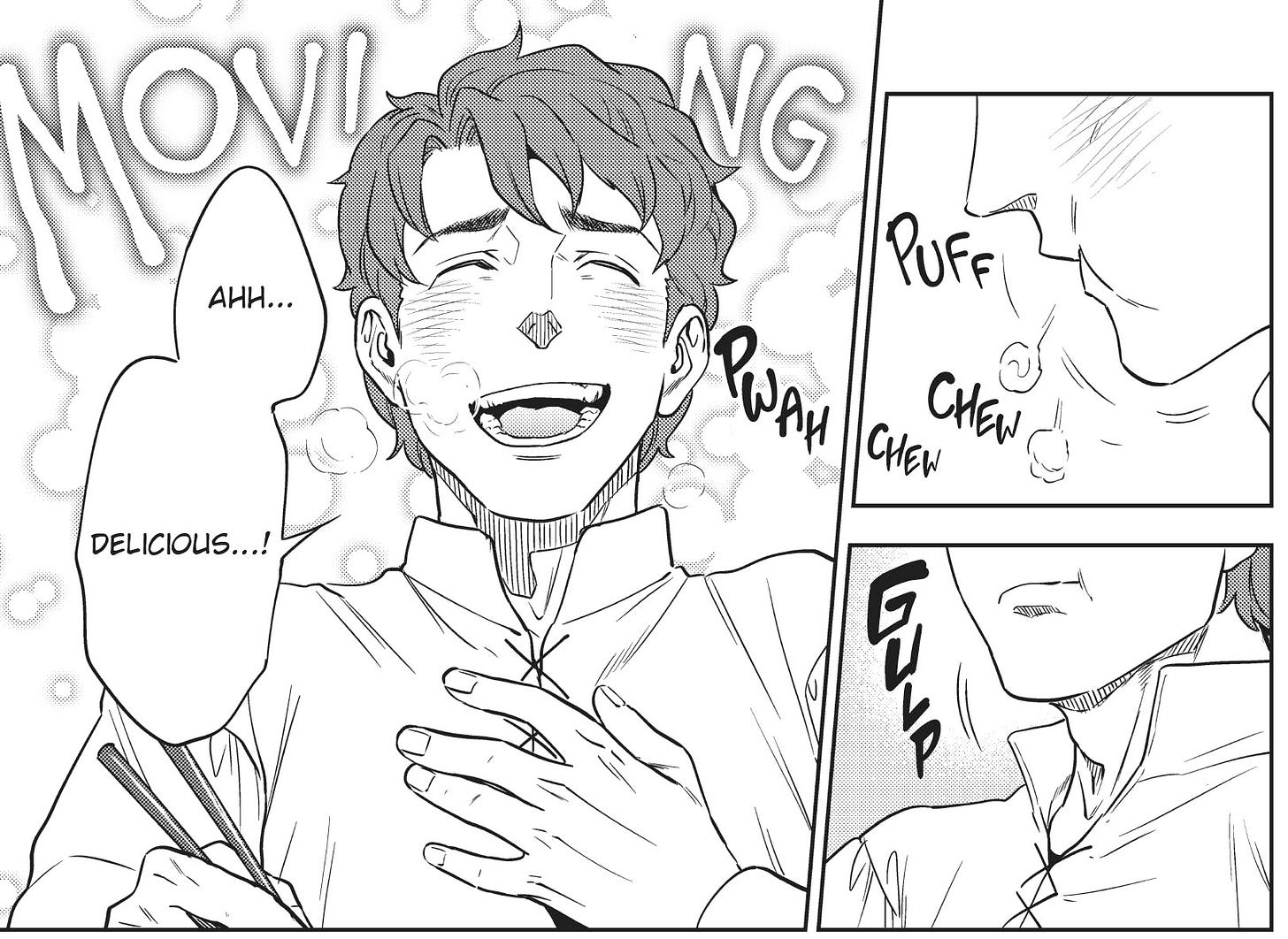
Fabulous talk! We are obsessed with watching Youtube videos of Japanese restaurants. Food manga scratches that itch as well.